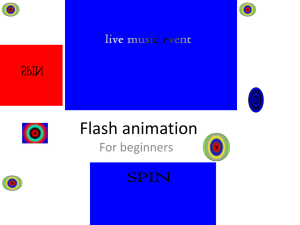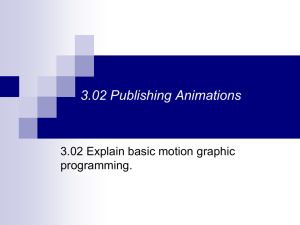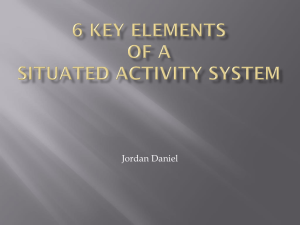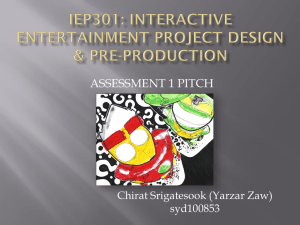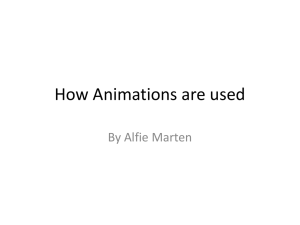Teacher`s PowerPoint - missallgar
advertisement
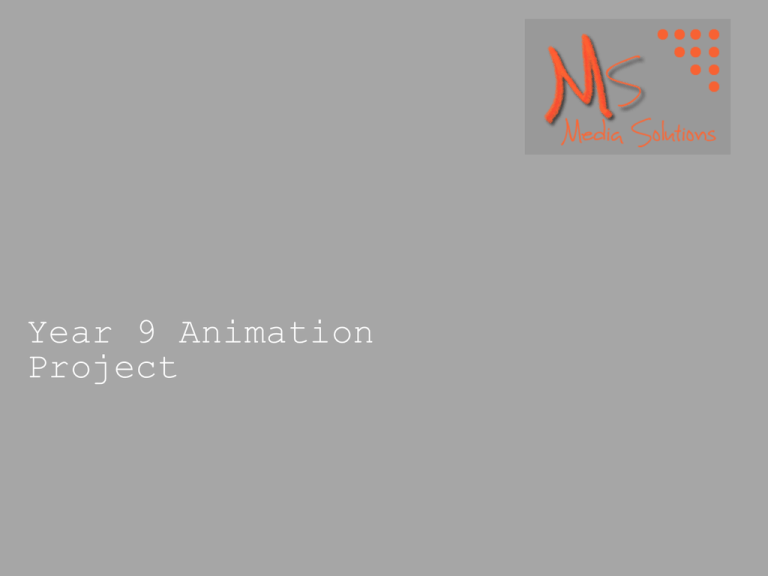
Year 9 Animation Project What are the different types of animation? Think Pair Share • http://www.youtube.com/watch?v=moBeQfJ7MBU • http://www.youtube.com/watch?v=S3hqS6JlKEc&fea ture=relmfu • History of CGI http://www.youtube.com/watch?v=fSXhoCCggB8 • Who made the first animation? • When was the first animation created? • How were the early animations made? • What was the first 3D computer-generated animation? • What is CGI? Where is animation used? Think Pair Share • • • • • Children’s cartoons, Films Gaming Architecture Medical simulations Stop motion (also known as stop frame) is an animation technique to make a physically manipulated object appear to move on its own. The object is moved in small increments between individually photographed frames, creating the illusion of movement when the series of frames is played as a continuous sequence. Dolls with movable joints or clay figures are often used in stop motion for their ease of repositioning. Stop motion animation using plasticine is called clay animation or "clay-motion". Not all stop motion requires figures or models; many stop motion films can involve using humans, household appliances and other things for comedic effect. Stop motion animation utilises this incremental change process in its own special way. Traditionally a movie film camera was started and stopped, one frame at a time. While the camera was stopped an animator would adjust the figure or object the camera was pointing at. The camera would film another frame - this would continue until all the animation was filmed Stop motion animation can be thought of as just a series of still photographs. Objects or puppets are moved and filmed frame by frame to simulate movement. Films like the original King Kong and Star Wars made heavy use of stop motion animation using miniatures and puppets. This was the only way to bring objects that cannot move by themselves to life on screen. The advent of computer generated imagery has removed stop motion animation from the mainstream but its unique effect and the realistic textures it brings (since actual materials are used in filming) means it will not die out anytime soon. It is still widely used in artistic films, shorts, and commercials. Notable feature-length films all done in stop motion animation and released in the “CGI boom era” are: • • • • Tim Burton’s Corpse Bride (2005) Chicken Run (2000) Wallace & Gromit: The Curse of the Were-Rabbit (2005) Coraline (2009) Its low entry price, and still unique "look" and "feel" on film means stop motion is still used on some such as in children's programming, as well as in commercials and comic shows such as Robot Chicken. The that the textures achieved with CGI cannot match the way real textures are captured by stop motion also valuable for a handful of movie makers, notably Tim Burton, whose puppet-animated film Corpse Bride was 2005. projects argument makes it released in Computer animation is the process used for generating animated images by using computer graphics. The more general term computer generated imagery encompasses both static scenes and dynamic images, while computer animation only refers to moving images. Modern computer animation usually uses 3D computer graphics, although 2D computer graphics are still used for stylistic, low bandwidth, and faster real-time renderings. Sometimes the target of the animation is the computer itself, but sometimes the target is another medium, such as film. Computer animation is essentially a digital successor to the stop motion techniques used in traditional animation with 3D models and frame-by-frame animation of 2D illustrations. Computer generated animations are more controllable than other more physically based processes, such as constructing miniatures for effects shots or hiring extras for crowd scenes, and because it allows the creation of images that would not be feasible using any other technology. It can also allow a single graphic artist to produce such content without the use of actors, expensive set pieces, or props. To create the illusion of movement, an image is displayed on the computer screen and repeatedly replaced by a new image that is similar to it, but advanced slightly in time (usually at a rate of 24 or 30 frames/second). This technique is identical to how the illusion of movement is achieved with television and motion pictures. For 3D animations, objects (models) are built on the computer monitor (modelled) and 3D figures are rigged with a virtual skeleton. For 2D figure animations, separate objects (illustrations) and separate transparent layers are used, with or without a virtual skeleton. Then the limbs, eyes, mouth, clothes, etc. of the figure are moved by the animator on key frames. The differences in appearance between key frames are automatically calculated by the computer in a process known as tweening or morphing. Finally, the animation is rendered. For 3D animations, all frames must be rendered after modelling is complete. For 2D vector animations, the rendering process is the key frame illustration process, while tweened frames are rendered as needed. For pre-recorded presentations, the rendered frames are transferred to a different format or medium such as film or digital video. The frames may also be rendered in real time as they are presented to the end-user audience. Low bandwidth animations transmitted via the internet (e.g. 2D Flash, X3D) often use software on the end-users computer to render in real time as an alternative to streaming or pre-loaded high bandwidth animations. Computer-generated imagery (CGI) is the application of computer graphics to create or contribute to images in art, printed media, video games, films, television programs, commercials, simulators and simulation generally. The visual scenes may be dynamic or static, and may be 2D or 3D, though the term "CGI" is most commonly used to refer to 3D computer graphics used for creating scenes or special effects in films and television. The term computer animation refers to dynamic CGI rendered as a movie. The term virtual world refers to agentbased, interactive environments. Computer graphics software is used to make computer-generated imagery for movies, etc. Recent availability of CGI software and increased computer speeds have allowed individual artists and small companies to produce professionalgrade films, games, and fine art from their home computers. This has brought about an internet subculture with its own set of global celebrities, clichés, and technical vocabulary. Not only do animated images form part of computer-generated imagery, natural looking landscapes, such as fractal landscapes are also generated via computer algorithms. Modern architects use services from computer graphic firms to create 3-dimensional models for both customers and builders. These computer generated models can be more accurate than traditional drawings. Computer generated models used in skeletal animation are not always anatomically correct, however, organizations such as the Scientific Computing and Imaging Institute have developed anatomically correct computer-based models. While computer generated images of landscapes may be static, the term computer animation only applies to dynamic images that resemble a movie. However, in general the term computer animation refers to dynamic images that do not allow user interaction, and the term virtual world is used for the interactive animated environments. Computer animation is essentially a digital successor to the art of stop motion animation of 3D models and frameby-frame animation of 2D illustrations. Computer generated animations are more controllable than other more physically based processes, such as constructing miniatures for effects shots or hiring extras for crowd scenes, and because it allows the creation of images that would not be feasible using any other technology. It can also allow a single graphic artist to produce such content without the use of actors, expensive set pieces, or props. To create the illusion of movement, an image is displayed on the computer screen and repeatedly replaced by a new image that is similar to the previous image, but advanced slightly in the time domain (usually at a rate of 24 or 30 frames/second). This technique is identical to how the illusion of movement is achieved with television and motion pictures. The uncanny valley is a hypothesis in the field of robotics[1] and 3D computer animation,[2][3] which holds that when human replicas look and act almost, but not perfectly, like actual human beings, it causes a response of revulsion among human observers. The "valley" refers to the dip in a graph of the comfort level of humans as a function of a robot's human likeness. Mori's original hypothesis states that as the appearance of a robot is made more human, a human observer's emotional response to the robot will become increasingly positive and empathic, until a point is reached beyond which the response quickly becomes that of strong revulsion. However, as the robot's appearance continues to become less distinguishable from that of a human being, the emotional response becomes positive once more and approaches human-to-human empathy levels. This area of repulsive response aroused by a robot with appearance and motion between a "barely human" and "fully human" entity is called the uncanny valley. The name captures the idea that an almost human-looking robot will seem overly "strange" to a human being, will produce a feeling of uncanniness, and will thus fail to evoke the empathic response required for productive human-robot interaction • Stop-motion – Button Moon / Flumps • Computer animation – SIGGRAPH 2008 Computer Animation Festival Preview • CGI – Avatar http://www.youtube.com/watch?v=SzPeMSn7MGw • Uncanny valley http://www.youtube.com/watch?v=CNdAIPoh8a4 • • • • • • • • Music Video Selling something - TV advert Educational Entertaining Historical Informative Film Trailer Topical / Event – Olympics or Euro 2012 Sound effects/Music Characters Speech 1. 2. 3. 4. 5. 6. 7. Export animation from I Can Animate Open MovieMaker and import movie Drag and drop movie clips on to the timeline Tools>Narrate Timeline Save Narration files Add Titles and Credits Finish Movie and Save to Computer Complete Animation Presentation • http://www.youtu\be.com/watch?v=qW5X1S6VKQ8&fe ature=related • http://www.youtube.com/watch?v=wRgTB9VS4HA&fea ture=related • http://www.youtube.com/watch?v=V1G8kXNMrks&fea ture=related • Mood boards • Rough sketches of one or more graphics for your animation • Annotated storyboards • Feedback from a classmate to improve your concept design • Theme: • Space – futuristic- Mars • Earth – Mountains – Grand Canyon National Park • Urban – graffiti – skateboarding – street • http://www.graffiticreator.net/ • Colours • Tools and graphical effects • Typeface (i.e. Scores) • • • • • • • Audience and Purpose Use of colour Use of bitmap and vector tools Graphical effects File type Size Resolution • In general web file resolution is 72 dpi, or dots per inch. • Print work requires at least 300 dpi resolution for photo images. These files can be rather large in file size. Font Style http://www.mega80s.com/ Fill Effect http://www.mega80s.com/ Space Invader Fill Effect Stoke Colour #FF6992 Fill Colour #FF5722 Fill Effect: http://www.mega80s.com/ Shape Edge: Feather (3) Shape fill: Gradient Ellipse Colours: #9933CC (purple) #E70CF3 (pink) #3333CC(blue) • Color Schemes Picker • http://wellstyled.com/tools/colorscheme2/index -en.html • • • • • • • Frames Frame rate Keyframe Movie clips Motion Tweening Shape Tweening Skeleton 1) Insert > New Symbol 2) Add layers for all the different parts of the character 3) Draw the different parts on the correct layer Then animate the different parts of the character using : • Shape tween • Motion tween & fading you must convert to a movie clip using Convert to Symbol>Movie Clip


